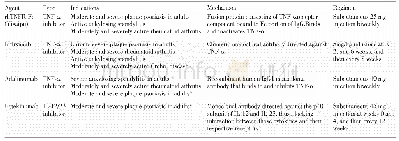《Table 2 Key properties of basic pollution patterns of underground river in karst region》
 提示:宽带有限、当前游客访问压缩模式
提示:宽带有限、当前游客访问压缩模式
本系列图表出处文件名:随高清版一同展现
《Pollution pattern of underground river in karst area of the Southwest China》
The recharge area pollution means that pollution source is found in the entrance of underground river and along the upper reach area of underground river,and due to the rainwater dripping or infiltration,the pollutants enter the underground river conduits from the said entrance or cavern fracture through surface runoff or vertical infiltration,thus causing the pollution of underground river.When the pollution intensity does not exceed the self-purification capacity of underground river,the pollutants may gradually decline along the runoff path(Dautovi?J et al.2014;REN Kun et al.2015;Vukosav P et al.2014)and the pollution is found along the upper reach,but not along the lower reach or is less serious along the lower reach(Table 2,Fig.3).When the pollution intensity exceeds the self-purification capacity of underground river,the pollutants may not noticeably decline along the runoff path,and the pollution is found both along the upper reach and along the lower reach.When the underground rivers affected by this type of pollution run through the regions with dense population,a very serious effect can be imposed on the people’s production and lives because of large pollution scope and huge population involved.The difficulty of pollution control work depends on structural complexity and concealment condition of underground river conduits,and sewage history.In case of sparse soil horizon under pollution source,unblocked underground river conduits,and short pollution history,the underground rivers have the characteristics of continuous flow or infiltration when the pollution source remains connected to the underground rivers.But if the pollution source is removed,the groundwater quality will get improved in a short time.In this case,it will be much easier to control pollution.However,in case of thick soil horizon under pollution source,blocked underground river conduits and long pollution history,the second pollution may occur because lots of pollutants are concentrated within aeration zone and in the sediments of underground rivers when the pollution source is removed(YANG Ping-heng et al.2013).It usually takes several years or even decades before the groundwater quality gets fully improved.Because of the rainfall’s effects,the underground rivers often have the characteristics of intermittent and declining pollution(ZOU Sheng-zhang et al.2016),which is rather hard to control.
| 图表编号 | XD0016467100 严禁用于非法目的 |
|---|---|
| 绘制时间 | 2018.06.01 |
| 作者 | ZHOU Chang-song、ZOU Sheng-zhang、ZHU Dan-ni、XIE Hao、CHEN Hong-feng、WANG Jia |
| 绘制单位 | Karst Dynamics Laboratory, MLR, Key Laboratory of Karst Ecosystem and Treatment of Rocky Desertification,Institute of Karst Geology, Chinese Academy of Geological Sciences |
| 更多格式 | 高清、无水印(增值服务) |





